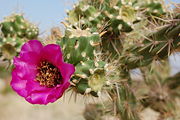Cylindropuntia imbricata
2008/9 Schools Wikipedia Selection. Related subjects: Plants
| Cane Cholla | ||||||||||||||
|---|---|---|---|---|---|---|---|---|---|---|---|---|---|---|
 |
||||||||||||||
| Scientific classification | ||||||||||||||
|
||||||||||||||
| Binomial name | ||||||||||||||
| Cylindropuntia imbricata Haw. ( DC.) |
||||||||||||||
| Synonyms | ||||||||||||||
|
Opuntia imbricata |
The cane cholla (or walking stick cholla, tree cholla, chainlink cactus, etc.) (Cylindropuntia imbricata) is a cactus found in arid parts of North America, including some cooler regions in comparison to many other cacti. It is often conspicuous because of its shrubby or even tree-like size, its silhouette, and its long-lasting yellowish fruits.
Range and habitat
Its range is dry areas from Utah, New Mexico, and west Texas (rarely northeast to western Kansas) south to Durango, Zacatecas, and San Luis Potosí—one of the most northern and eastern ranges of all chollas. It occurs at altitudes from 1200 m to 2300 m (4000 to 7500 feet) and is hardy for a cactus ( USDA Zone 5A).
In parts of its range, often just below the pinyon- juniper belt, it can be abundant, surrounded by low grasses and forbs that are brown most of the year; in such places chollas are conspicuous as the only tall green plant. Plants may form thickets or be spaced at a few times their width in "gardens".
Description
The above-ground part consists of much-branched cylindrical stems, the end joints being about 3 cm in diameter. The joints, unlike those of some chollas, are hard to detach. The stems are highly tubercular (lumpy) with a pattern of long oval lumps. A typical height is about 1 m, but exceptionally it can grow to 4.6 m (15 ft) with a "trunk" diameter of 25 cm (10 in). The width is often similar to or somewhat greater than the height. The stems are armed with clusters of up to about 10 red to pink spines, which may be 3 cm (1.2 in) long and are barbed and sharp enough to easily penetrate leather gardening gloves. The stems and fruits also have many spines or "glochids" about 1 mm long that can detach and stick annoyingly in the skin.
This species blooms in late spring or early summer. The flowers, at the ends of the terminal joints, are purple or magenta, rarely rose-pink, about 5 cm (2 in) wide. The fruits are yellowish, tubercular like the stems, and shaped something like the frustum of a cone, with a hollow at the wide end where the flower fell off; they are often mistaken for flowers. The plant retains them all winter. Unlike the fruits of some Opuntia species, they are dry and not tasty, though the Indians of Arizona and New Mexico are said to have eaten them.
Cultivation
The plants are sometimes grown as ornamentals, despite their sharp thorns and tendency to spread. Dead stems decay to leave a hollow wooden tube with a pattern of lengthwise slits. These are sometimes used as canes or to make curios. The Roman Catholic Penitentes of New Mexico formerly tied fresh stems to their bare backs in Holy Week processions.
